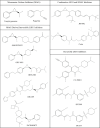Lysine specific demethylase 1 is a molecular driver and therapeutic target in sarcoma
- PMID: 36686841
- PMCID: PMC9846348
- DOI: 10.3389/fonc.2022.1076581
Lysine specific demethylase 1 is a molecular driver and therapeutic target in sarcoma
Abstract
Sarcomas are a diverse group of tumors with numerous oncogenic drivers, and display varied clinical behaviors and prognoses. This complexity makes diagnosis and the development of new and effective treatments challenging. An incomplete understanding of both cell of origin and the biological drivers of sarcomas complicates efforts to develop clinically relevant model systems and find new molecular targets. Notably, the histone lysine specific demethylase 1 (LSD1) is overexpressed in a number of different sarcomas and is a potential therapeutic target in these malignancies. With the ability to modify histone marks, LSD1 is a key player in many protein complexes that epigenetically regulate gene expression. It is a largely context dependent enzyme, having vastly different and often opposing roles depending on the cellular environment and which interaction partners are involved. LSD1 has been implicated in the development of many different types of cancer, but its role in bone and soft tissue sarcomas remains poorly understood. In this review, we compiled what is known about the LSD1 function in various sarcomas, to determine where knowledge is lacking and to find what theme emerge to characterize how LSD1 is a key molecular driver in bone and soft tissue sarcoma. We further discuss the current clinical landscape for the development of LSD1 inhibitors and where sarcomas have been included in early clinical trials.
Keywords: LSD1; epigenetics; mesenchymal development; oncogenic fusion protein; sarcoma.
Copyright © 2023 Dreher and Theisen.
Conflict of interest statement
ET has received research funding from Salarius Pharmaceuticals, but this work is not supported by that funding. The remaining author declare that the research was conducted in the absence of any commercial or financial relationships that could be constructed as a potential conflict of interest.
Figures



Similar articles
-
Lysine-specific demethylase 1 is highly expressed in solitary fibrous tumors, synovial sarcomas, rhabdomyosarcomas, desmoplastic small round cell tumors, and malignant peripheral nerve sheath tumors.Hum Pathol. 2011 Nov;42(11):1667-75. doi: 10.1016/j.humpath.2010.12.025. Epub 2011 Apr 29. Hum Pathol. 2011. PMID: 21531005
-
Lysine-specific demethylase 1 (LSD1/KDM1A/AOF2/BHC110) is expressed and is an epigenetic drug target in chondrosarcoma, Ewing's sarcoma, osteosarcoma, and rhabdomyosarcoma.Hum Pathol. 2012 Aug;43(8):1300-7. doi: 10.1016/j.humpath.2011.10.010. Epub 2012 Jan 13. Hum Pathol. 2012. PMID: 22245111
-
Therapeutic opportunities in Ewing sarcoma: EWS-FLI inhibition via LSD1 targeting.Oncotarget. 2016 Apr 5;7(14):17616-30. doi: 10.18632/oncotarget.7124. Oncotarget. 2016. PMID: 26848860 Free PMC article. Review.
-
Chromatin profiling reveals relocalization of lysine-specific demethylase 1 by an oncogenic fusion protein.Epigenetics. 2021 Apr;16(4):405-424. doi: 10.1080/15592294.2020.1805678. Epub 2020 Aug 25. Epigenetics. 2021. PMID: 32842875 Free PMC article.
-
Histone demethylase LSD1 controls the phenotypic plasticity of cancer cells.Cancer Sci. 2016 Sep;107(9):1187-92. doi: 10.1111/cas.13004. Epub 2016 Sep 1. Cancer Sci. 2016. PMID: 27375009 Free PMC article. Review.
Cited by
-
Telomeres and telomerase in Sarcoma disease and therapy.Int J Med Sci. 2024 Aug 6;21(11):2065-2080. doi: 10.7150/ijms.97485. eCollection 2024. Int J Med Sci. 2024. PMID: 39239547 Free PMC article. Review.
-
Apoptosis Genes as a Key to Identification of Inverse Comorbidity of Huntington's Disease and Cancer.Int J Mol Sci. 2023 May 27;24(11):9385. doi: 10.3390/ijms24119385. Int J Mol Sci. 2023. PMID: 37298337 Free PMC article.
-
Epigenetic therapies targeting histone lysine methylation: complex mechanisms and clinical challenges.J Clin Invest. 2024 Oct 15;134(20):e183391. doi: 10.1172/JCI183391. J Clin Invest. 2024. PMID: 39403928 Free PMC article. Review.
References
Publication types
LinkOut - more resources
Full Text Sources
Other Literature Sources

